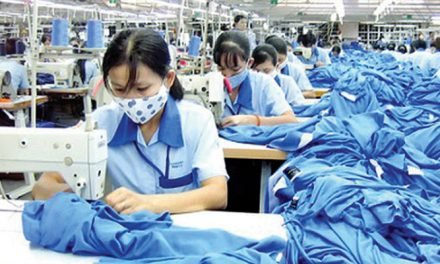Scientists in the University of Borås have developed a method for degrading the dyes, released in the environment during the process of dyeing textiles, and purifying the waste water. One problem the textile industry faces is that even the most efficient dyeing processes require large amounts of water, energy, and chemicals, damaging the environment.
Enzymes are used to initiate a degradation process of dyes and other chemicals. To achieve this, the enzymes need to be attached to the surface of a support material in order for them to function maximally. The degradation is usually done with the help of acids or oxidising solutions at high temperature and for a long time in the conventional methods. This means that the entire dyeing process consumes large amounts of water and energy and leads to emissions where large quantities of the dangerous substances are released into the environment.
In her research project, doctoral student May Kahoush worked on methods that contribute to the waste water’s being purified in an environmentally friendly way. “In the dyeing process, the excess dyes and chemicals are flushed out with the waste water, which causes great damage to the environment. My goal is to develop an eco-friendly method of purifying the waste water before it is emitted,” she explains.
She has investigated three different methods, all of which facilitate a solution that benefits both the environment and the textile industry by reducing the consumption of water and energy, as well as the emission of hazardous chemicals. The challenge has been how to attach the enzymes to a suitable material.
“We have used felted carbon fibre textiles, a common material used in many different applications, and using these textiles the enzymes can attach and help degrade the dye molecules. The carbon fibre textile is a porous lightweight material, that resists corrosion and that is easily formed, which can be used as an alternative to expensive, rigid metals. The carbon fibre also has good electrically-conductive properties, which is a prerequisite for getting the desired properties in electro-chemical applications,” she said.
One problem, however, is that the carbon fibre textile is water repellent. In this case, she wanted the material to absorb water, which is a prerequisite for the enzymes to be able to attach to it. Thus, there has to be a pre-treatment of the material. In one method, she used an eco-friendly substance from a flower, the gardenia, which causes the enzymes to attach directly to the surface of the carbon fibre material. In the other method, she used an environmentally-friendly coating to attach the enzymes, and in the third method a cold plasma treatment was applied. The first two methods only demand small amounts of water, while the plasma method requires neither water nor chemicals and needs a low amount of energy.
Due to the enzymatic activity of the enzymes on the carbon fibre material, the substance hydrogen peroxide is formed which breaks down the dyes used in textile dyeing. This contributes to reduced emissions of the dyes and other pollutants.
The methods for immobilising the enzymes have several advantages, such as that they provide a stable process and that the enzymes can be reused. If they had floated around freely instead, there would have been a risk that residues of the enzymes would have remained on the dyed textiles, which could cause allergies and other unwanted effects.
In addition to the purification of water, the method can be used to identify substances to which the enzyme in question reacts, in this case to glucose. It is also possible to generate electricity from biological substances used to produce sugar or alcohol. The project was implemented within SMDTex (Sustainable Management and Design in Textiles), a doctoral programme within Erasmus Mundus on sustainable management and textile design.






















